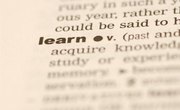The English language can be seemingly difficult to learn. However, once you grasp the parts of speech in a sentence, you are on your way to mastering reading and writing. Traditionally, there are eight parts of speech in English grammar: nouns, verbs, adjectives, adverbs, prepositions, pronouns, conjunctions and interjections. With practice, finding the parts of speech in a sentence can be easy.
Learn the basic parts of speech first. Nouns, verbs and adjectives are the main three parts of speech. Other parts of speech, such as adverbs, are subsections of these basic parts. A noun is defined as a person, place, thing or idea. For instance, "apple," "Julie," "Mt. Vernon" and "sorrow" are all nouns. A helpful tip: Look for capitalized words when identifying nouns. This often means that the word is a person or place. A verb is an action word such as "jump" or "talk." Verbs can often end in "ing" or "ed," but not always. An adjective describes a noun. For instance, in "yellow hat," "hat" is the noun and "yellow" describes the hat. "Yellow" is an adjective. You will often find adjectives next to nouns in a sentence.
Understand the definition and usages of the smaller parts of speech, including articles, adverbs, pronouns, prepositions and conjunctions. There are three articles: "a," "an" and "the." Articles are often found in front of nouns, such as "the cat." Adverbs describe a verb, adjective or another adverb. Adverbs often end in "ly," but not always. Some examples of adverbs are "slowly," "very" and "really." Pronouns are words that replace nouns. You will come across pronouns such as "I," "you," "he," "we," "she" and "it." A preposition links a noun to another word. Examples of prepositions include "to," "at," "after," "on" and "but." Conjunctions, on the other hand, join clauses or words. It helps to think of conjunctions as bridges. Examples of conjunctions include "and," "or" and "but."
Find the last part of speech: interjections. Interjections are short exclamations often punctuated with an exclamation point or a comma. Interjections usually show emotion or surprise. Examples of interjections include "hi" and "wow." For instance, in "Hi! How are you? Well, I had a rough day," you can identify "hi" and "well" as interjections.
Related Articles
References
Writer Bio
June Lee has been writing professionally since 1999. Her areas of expertise include education, art, fashion and travel. She holds a B.A. in English and has been writing online professionally since August 2010.











